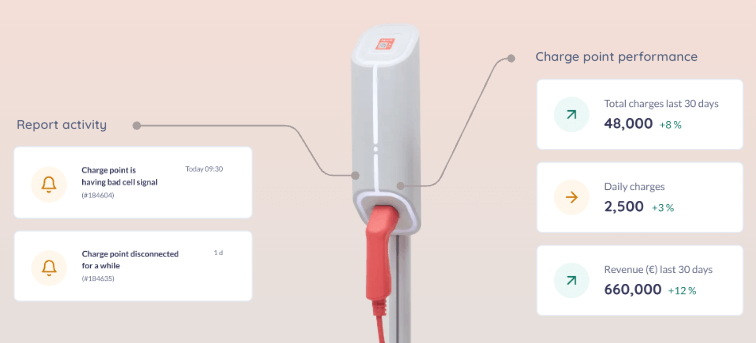11 April 2024
From CTO to CEO – the three skills you need to make the journey by Monta’s Casper Rasmussen
Are you a tech leader who aims to become a CEO? Good news – Casper Rasmussen, Monta’s CTO & CEO, believes your technical experience could be an excellent base for a business management role. But you need to build up new skills on top of it. To do that, you need to try to understand the perspective of your peers outside the IT department.
The CTO vs Status Quo series studies how CTOs challenge the current state of affairs at their company to push it toward a new height … or to save it from doom.
Do you want to be a CEO? The knowledge you need is outside of the IT department
Casper Rasmussen has been a CTO for over 10 years. In 2020, he co-founded Monta, where he got to step out of the tech department and take control of the entire organization as a CEO.
He told us that to succeed as a CEO, you need to develop your skills in three areas:
- storytelling,
- delegating,
- aligning.
If you think it’s easier said than done… you’re right. Perhaps the story of Monta’s CTO and CEO will give you an idea of how to begin. Say hello to Casper.
About Casper & Monta
Bio
Casper first became a CTO in 2013 at Monster Lab. He led a team of over 750 engineers in 20+ countries worldwide to ensure timely and secure delivery. In 2020, he co-founded Monta and assumed a dual CTO-CEO role. He focused on developing and communicating a vision of Monta’s future as a leading EV charging platform.
Expertise
Team management, software architecture, software delivery, fundraising, mobile applications, Android, PHP
Monta
Founded in Denmark, Monta aims to connect all the dots in the scattered EV ecosystem. By creating a unified and accessible charging experience through software for drivers, solution providers, and site owners, Monta wants to help speed up the transition to electric mobility. As of 2024, Monta has over 200 employees and offices in Copenhagen, Oslo, Berlin, Paris, London and Barcelona.
Monta’s vision
Jakub Piłucki: Hello Casper. Thanks for agreeing to this interview. I know that it is a busy time for Monta. In 2023, your company increased revenue by 600%, nearly doubled the number of employees, and opened new offices in Paris and Barcelona.
A few months ago, you helped lead a €80 million investment round. What impact does it have on Monta in 2024?
We’re going to have 400 new colleagues by the end of this year – this says it all, but I’ll elaborate.
Monta raised 80 million euros in a B series at the end of 2023. We announced it early this year. With this much capital going in, we can double down on everything we have done so far to continue building software solutions for the EV charging industry.
We’re going to use the funding to power up an ambitious growth plan over the next four years. We want to outpace the competition in Europe and take the dominant position there. We also want to expand further around the world.
Monta builds EV software, but in the commentary on the investment, you also said that the company is the backbone of a global shift toward decentralized electrification. Is this how you’ve always seen Monta’s mission?
Let’s take it from the start.
I have been an EV driver since 2017. I was familiar with the industry, and I got the idea for the business in 2020. A few circumstances led to this.
First, the charge points available around me started becoming open standards, so you could work on top of them. But the charging experience was horrible. Only Tesla had a decent one.
Then, I started understanding the power grid more and realized that the issue was bigger than I thought – it required a systemic approach.
One thing is solving the EV charging UX. The bigger picture is about creating a decentralized entity for the production and consumption of energy in local areas. To make it work, the energy consumption will have to double or triple without upgrading the grids too much. I realized that’s the direction we’re heading and that it could take 10 years before we get there.
My goal is to position Monta in a way that will allow it to be the go-to EV charging software solution when the market is ready.
When will it be ready?
When there is wider access to batteries and when virtual power plants are common.
As we prepare for that moment, we expand our software suite and connect it to an ever-growing list of charging assets. This will give us the advantage later.

The changing role of a CTO
I mentioned Monta’s mission and overall direction because you can now directly shape it as a CEO.
CTO’s role is more specialized and was even more so a decade ago when you took on the role. The CTO was in the grip of a financial department because the technology they shaped was seen as a cost. Do you remember that time?
To think of IT as a cost center is a classic corporate approach. In this classic model, technology runs under the umbrella of the CFO.
Companies that consider software their main product or service, something they sell, have a more independent CTO running the operation.
An environment like this allows IT to move freely and innovate. After all, they are now seen as responsible for the company’s revenue rather than the cost.
COVID came at the end of the cloud computing revolution. You co-founded Monta and became a CEO/CTO about half a year into the pandemic. Companies were in a rush to digitize. Thanks to the cloud, they could do it much faster. The role of a CTO shined. Did the pandemic have something to do with your new role as a CEO?
For me, the cloud revolution started early. My former company got on AWS around 2011.
The early CTO adopters could see how quickly they could do things, even if they didn’t use most cloud functionalities. Typically, they just made their existing apps work in the cloud. It was also an enormous challenge to move tons of apps there.
Small companies were the first to pick up the cloud. Big corporations move at a slower pace. That’s why Microsoft’s Azure only started generating serious earnings around 2017 or even later.
Monta came around during the pandemic, but it wasn’t what drove me to become a CEO. I wanted to set up the best team for the challenge I laid out.
When you have a hundred engineers, you can no longer program. At that point, leading IT is about business. You need to understand the big pieces and put them together. You don’t spend time thinking about how Kubernetes works or if you should use this database or that one. Other people do that. Your job is to explain the overall technology strategy and the way it supports business to the rest of the C-level managers and all stakeholders.
This shift happened gradually for me over the 10 years of being a CTO across different companies. I got more into the business side of things, including budgeting and operations, since we didn’t have a COO.
So, my thinking as a CTO naturally shifted towards the big picture. That’s also what being CEO is about.
The CEO’s job is to convince users, team members, and investors to believe in their vision and join them. Then, they must keep people engaged throughout the journey.
It’s not really about making spreadsheets or leading legal negotiations. You can contribute here and there if you want to, but it’s not your core job.
I decided once that if I were to become a CEO, I’d spend my time doing things I’m good at and find the right people to deal with everything else. The beauty of starting your own company is that you can shape the job into what you want it to be.
Do you see other big trends that could increase the importance of a CTO? If cloud computing made companies rethink their products, perhaps AI could do the same.
Small companies quickly adapt or change their business model to incorporate AI. That’s why I recommend that each tech leader figure out how AI can influence their business.
You need to use solutions such as data warehouses to structure your data and make it usable for AI tools. That’s just a precondition for doing anything smart with AI.
Reimagining your business using AI is a harder task. Using AI to optimize your workflows and make your teams more efficient is easier. You can achieve that by implementing a couple of apps, such as GitHub Copilot – a pair programming tool that provides real-time AI-based suggestions. If you can demonstrate that AI benefits the organization, you can strengthen your position as a CTO.
At Monta, we’ve been using Copilot for a while and had impressive results. We run an internal survey to gather feedback. We learned that most programmers report a productivity increase of about 10 percent, up to 20-25 percent.
Becoming a CEO
The increasing role of a CTO might mean that more IT leaders will eventually become CEOs like you. According to one survey, 51% of CTOs want to become CEOs. But only some want it to be their immediate next move. What do you think could be the reason?
I can’t say I’m surprised by the results.
When you combine a technology background with the high-level business experience you get as a CTO, you already have many skills to succeed as a CEO.
Still, while I believe that a CTO can make a great CEO, I don’t think they are the most likely to have this ambition. Many CTOs like staying within their own niche and doing their own thing. If you were to run this survey among COOs, for example, I’m sure that about 90% or more would choose to become a CEO.
And when did you decide that being a CEO is something you’d like to try?
At a different company, I’d consider remaining just a CTO and getting a more business-oriented or operations-oriented CEO. But Monta is a very technical project. You want a CEO who can navigate the technological space well. This technical knowledge also worked well for sales and investor relations. It gave my arguments more depth.
You combine the role of a CTO and CEO. Did your company ever consider separating these roles again by getting a new CTO on board? Why is the current setup most efficient for Monta?
It’s a natural step to separate these two roles at some point. As you scale your organization, it’s getting too hard to do both.
Today, I mitigate the issue by having three 3 VPs of engineering. Each of them runs a team of about 30 engineers. That way, I have strong technical leadership around me. So, I’m not part of the day-to-day low-level decision-making process regarding engineering and architecture.
Still, I think I’ll look into the issue of adding a CTO again in the foreseeable future.
CTO-turned-CEO’s impact
Let’s focus on the time since December 2020 when you took on the role of a CEO in addition to being a CTO. I’d like to learn about the impact this had on Monta in a few areas. Let’s start with team management. Did you introduce some new policies that you couldn’t as a CTO?
Back in December 2020, when we started, there were only seven people. The management scheme was loose. When you have so few people, there are no processes. And that’s for the best. You get to be the most creative and agile.
Then, as you start scaling, you figure out what processes and systems you need.
My CPO and I joined the betting sessions so that we could understand what teams did and why they did it. This is a good way to get a high-level picture of everyday operations. I may not know as many details as a separate CTO would, but as long as I know the reason why we do something, that’s what matters.
These things get more critical as you get bigger because everyone needs to understand how other teams work.
I always believed that you shouldn’t introduce too many new things. The team needs to be ready for them. They will spend too much time working around a process if they’re uncomfortable with it. But if you introduce it too late, you may lose a lot of time, too. People will be unable to get the information they need quickly enough in a large organization unless there’s a process that simplifies navigation. Don’t introduce a process until necessary — it is a good rule of thumb.
You seem to put a lot of effort into making your teams feel comfortable with the changes you make. What do you think about the idea of self-managed teams?
I would say that our teams are fairly autonomous. We have different divisions. The teams within each division focus on a small part of the product. Each division also has its own core KPIs. Within these bounds, they can move quite freely.
Teams also get assignments from other departments, but they won’t be done until they are placed on the roadmap first. They make these decisions during the betting sessions. There, they decide what to do in the next sprint. Anyone can join the session to make an argument of their own.
Of course, some things need to be done no matter what. We’re entering new markets. This brings new regulations, localizations, and requirements to account for in our software. The expansion team determines these needs and puts them on the roadmap. Signing a contract with a significant customer may also bring out the need to deliver something quickly.
A CTO is sometimes at odds with the product department. How did you change the product development when you could shape its high-level vision?
You have a big advantage if you are a CTO and believe you can solve a problem with a tech solution. In such a case, the organization will most likely allocate its money to the IT department. If there is no visible solution or time to be spared for new initiatives, then the money will go elsewhere.
However, there are other limitations for the IT department. For example, expansion forces the allocation of money in certain areas.
Product development also has its limitations. At innovative organizations like Monta, some tasks take a lot of research and creativity. You won’t necessarily speed this process up by adding more engineers. These projects are hard to estimate, and not everyone has the right expertise.
As a CEO and CTO, I decide where to allocate funds. To succeed, I need to gather all the knowledge I can, from inside and outside of the company, to see the challenges ahead.
Delivery speed is something the product team emphasizes, while the tech department naturally cares about architecture quality and scalability. How did your promotion influence the balance between these two aspects?
Delivery changes the most. We have been iterating on that for over two years.
At the start, it was fully Agile. Then, we moved to one-week sprints. Now, we have six-week sprints with betting sessions.
As I said before, we figure this out gradually with the team.

The skills you need
Let’s talk about the skill set of a technical CEO. As a CTO of 10 years, you have the knowledge to drive the direction of software development and architecture at Monta. How did your technical leadership change when you took on the new role?
You get a lot less time to do anything. You need to delegate more than ever before. To be able to do that, you should get new people on board more quickly.
Getting a VP of Engineering was crucial when we exceeded 10 engineers. When there were a couple dozen people, we also brought in a COO to deal with all the financial and legal operations, especially those concerning expansion.
What about soft skills that are needed to balance various stakeholders’ needs across the organization? How much of the challenge was new to you when you started as a CEO?
I was lucky to have constant contact with customers over the course of my 10-year career as a CTO. I got used to presenting on stage and participating in long online meetings.
Talking to stakeholders was never an issue for me. I’ve been working on my ability to communicate my thoughts and vision clearly for a long time.
As a CTO, I learned how to budget or set up payrolls. My co-founder and I handled it from the start at Monta.
One skill area I needed to polish up was organizing the fundraising process.
Fundraising is about telling your story in a very bold way. It’s also about creating a viable business model, which involves the thing you build and your potential markets or teams. You need to be able to spot business opportunities and make a lot of educated guesses about the future.
I never tried this on such a scale. I had to learn that on the job.
Did you consider filling the knowledge gaps in other ways? Some leaders earn an MBA when they take on a broader role in an organization. You got a Board Certificate. Was it worth it?
I considered taking an MBA. But then I realized that my next job would probably not be in the corporate world. It would most likely be a small company with an environment where formal education is less important.
As for the board certificate, I got it because I started doing more advisory roles on boards. I took this course to understand the nitty-gritty of working on a board. It was hugely helpful.
The goal of getting the board certificate is to understand corporate law and what it means to be a board member from a legal standpoint – what you sign up for and your liabilities and duties. You must run your company according to the law. I also learned how to read a PnL income statement, set up different stock classes, and value companies. All this knowledge protects you and your company.
That’s why I can recommend a course like this to anyone who aims to be a C-level executive.
It seems like a course like this would also be helpful as preparation for other specialized roles. One interesting career alternative to a CEO is a CTPO. How would you compare the required skill set to your combined CTO-CEO role?
Until recently, that was kind of my role. I was a CEO and a CTPO because I was in charge of both product and technology. But then I promoted one of our VPs of Product to the role of a CPO.
However, I believe that product and engineering must be considered one. If you split them into separate departments, their teams must work closely together. We have one department called Product Engineering for that reason.
Some believe that products and engineering are too complicated to be run by one person.
Having a separate CTO and CPO in a large company makes sense. But they need to be very aligned on where they’re heading. It doesn’t make sense for the production to do a lot of work and research on a specific initiative if the tech cannot support that because they are busy migrating or fixing security issues.
Production and technology need to align with planning, budgeting, and the definition of “good.” There is no decision that doesn’t impact the other side. For example, choosing a technology has a big impact on production. Depending on whether you go for Java, JavaScript, or .NET, you will have different speed, quality, or access to talent.
Such an alignment is not easy to achieve. I’ve witnessed companies fail to do it many times. Typically, the reason is the lack of ability to compromise between short- and long-term goals.
When a company is in the early stages of growth and looking for a product-market fit, you often want to be able to move fast, break things, and test out as many solutions as possible. Some tech leaders disregard this and go for a complex low-level technology that may be powerful and scalable but requires multiple experts and takes much more time at the start.
If your organization is at an early stage, a good idea is to pick something that a single full-stack engineer can use to build a feature. There is no need for a complicated design at this point. All you need is to pull components together to make something workable. When you have a UX, backend, frontend, QA, and PM person in one, you can move very quickly.
A solution like this may need a significant reworking when you scale. And you could argue that it would have been better to do it properly from the start.
When you know what you need to build from the start, then go for it. You’re going to have the best return on investment that way. But most of the time, you don’t have that luxury. I can hardly think of any cases that went that smoothly.

If you want to be a CEO…
If you had one piece of advice for a CTO aspiring to be a CEO, what would it be?
Step out of the product engineering department and spend more time on the other side of the business. Use it to learn about budgeting, customers, and market strategy.
To do that, you must participate in various operational meetings. You don’t need to be extremely active there, but you should ask questions if you don’t understand something. It’s not a problem to ask a CFO to explain what a particular spreadsheet represents or what a metric relates to.
Resources
Could you recommend some materials, such as books or podcasts, that could help CTOs become more complete leaders ready to broaden their roles?
Instead of sitting and reading a book, I’d recommend you talk to the engineers, designers, and salespeople to understand what they work on and the problem they’re trying to solve.
But speaking of resources, there’s a podcast called The Modern CTO. It started a couple of years ago. They interviewed most of the big CTOs out there. Back in the day, I listened to it all to get a more comprehensive understanding of the technology space.
What’s next? Three actions for CTOs to take
What do you think about Casper’s stories? Do you feel inspired to start working towards becoming a CEO? Or perhaps you already wanted to do that, but now you’re more confident about your next move?
Just remember:
- Be a bold storyteller – work on your communication skills to pull your teammates and investors towards the vision of what your company will achieve.
- Trust people – even as a CTO, you can’t do everything yourself. That’s even more true for a CEO. Find the best people to delegate tasks to and give them much freedom to deliver.
- Educate yourself through practice – education is great, but everyday business practice is a CEO’s best teacher. Step out of the tech department to learn more about sales, marketing, and users. Understand the relationship between the needs of different departments so that one day, you can help align everyone towards the same objectives.
Good luck with shaping your C-level career.
Want to learn more about Monta and its mission?
Start from the EV charging glossary that covers subjects such as smart charging, grid balancing, demand site management, or range anxiety.


